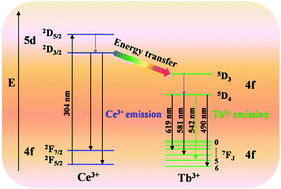Ce3+ and Tb3+ activated Ba3P4O13 phosphors based on energy transfer behavior
Abstract
A variety of Ce3+ and Tb3+ doped Ba3P4O13 phosphors were synthesized via the solid state reaction method. Their photoluminescence properties, decay lifetime, thermal stability and luminous efficiency were investigated. The possible energy transfer mechanism was proposed based on the experimental results and detailed luminescence spectra and decay curves of the phosphors. The critical distance between Ce3+ and Tb3+ was calculated by both the spectral overlap method and the concentration quenching method. The energy transfer mechanism from Ce3+ to Tb3+ is determined to be dipole–quadrupole interaction. Furthermore, Ba3P4O13:Ce3+,Tb3+ exhibits relatively excellent thermal stability and its intensity remains 92.7% of the initial intensity at 150 °C.



 Please wait while we load your content...
Please wait while we load your content...